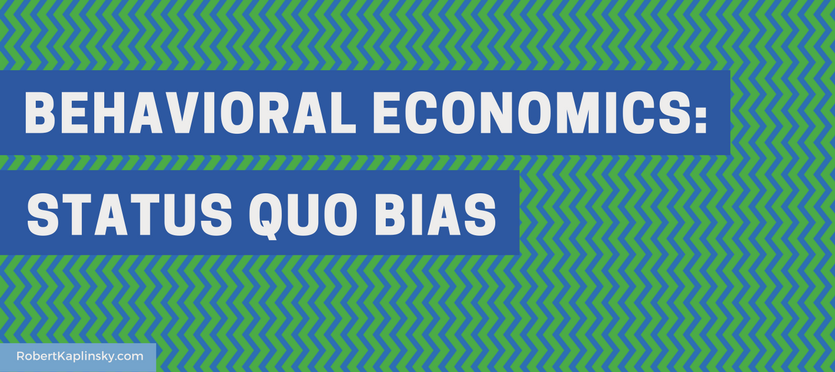NOTE: This is one of a series of ten blog posts on cognitive biases that have applications in education.
Most people tend to stick to a routine even though there is no requirement to do so. Customers order the same items off the menu even though there may be other meals they would enjoy more. Drivers take the same familiar route home, even if other routes may save them time. Students may sit in the same seats in class, even if they can sit wherever they want. Organizations use this to their advantage when they offer a free trial that automatically converts to a paid subscription once the trial ends. They expect that the status quo bias will keep people subscribed even though they may not necessarily want what they’re paying for. In general, people may find themselves continuing to do something because they’re used to it, without questioning whether there might be a better way.
This happens in math education as well. Consider where the emphasis on procedural skills came from. Only a few generations ago tools like calculators were rare and people had no choice but to do the computations by hand. As a result, it was necessary to spend significant time teaching procedures because there was no realistic alternative. Over time, those once valuable skills became less needed as people used technology instead of doing the math by hand. Yet time spent educating students on those skills did not decrease in proportion to their usage. Instead, a significant amount of time spent in K-12 math education has been spent on procedural skills that are rarely used in real life. Just like with eating at a restaurant, we tend to stick with what we usually do rather than make a conscious choice to try something new.
Alternatively, the educator may be aware of other options but may not be convinced that the new option is better than the one currently being used. If that’s the case, it may be worthwhile to strategically ask questions like:
- If you had never seen either option before, how could you tell which method would be most effective?
- Why would someone use this option?
- Why would someone use the other option?
The goal would be to reduce the effect of status quo bias by getting the educator to shift his or her viewpoint from choosing between old and new options to choosing between new and new options.
Consider how students progress from solving one-step equations (x + 3 = 10) to two-step equations (2x + 3 = 10). Most students wind up using a guess and check strategy for solving one-step equations. This usually works well enough for them. Later though, when they learn two-step equations, that strategy works less well. They will likely be presented with new strategies for solving the problem but may resist using them because they aren’t the way they are used to solving seemingly similar problems.
One potential way to deal with this is to discuss this cognitive bias with them. Routines are great for a reason: we don’t have to think deeply about doing them. However that by itself doesn’t make them something we should permanently hold on to. When helping students shift from an old strategy to a new one, consider laying out the merits of each, side by side, so that students have a better idea of appropriate usage for each.
What other instances of status quo bias are you seeing? How do you suggest we account for them?


Great post, Robert. I’m enjoying this series. The place I see status quo thinking having an especially out-sized influence is among parents. If we’re ever going to make the case for meaningful change in math education, we’re going to have to convince families we’re trying to change the status quo for good reasons, not just change for the sake of change, or fads.
Thanks Tracy. That is so true! It is now making me think that “Implications for working with parents” could be a category of its own across this series. Fortunately the same techniques still apply to them. I appreciate you for pushing my thinking.
This is very similar to what I have been thinking about over the past couple of weeks. I would like to begin conversations with teachers in regards to remediation. The common view appears to be remediation is the teacher explaining the steps the same way using multiple example problems to every student in the classroom. The issues I see with this make me ponder the following questions:
How have you used formative assessments to identify areas of weakness?
What instructional approaches have you used to help students develop their understanding?
Was this effective for all students? (The answer to this obvious)
What other instructional strategies have you considered?
Hi Jenise. Your statement of “This is very similar to what I have been thinking about over the past couple of weeks.” was a common thread throughout my exploration of behavioral economics. I constantly felt like the cognitive biases I learned about described phenomenon that I had anecdotal observations of but have not described articulately.
Certainly responses to the questions you ask will be affected by how pronounced the status quo bias is.
Interesting stuff, amigo. This reminds me of Henry Ford’s quote, “If I had asked people what they wanted, they would have said faster horses.”
It’s comes from the question: do customers really know what they want? Carrying this over into education, do students really know what they want? Do teachers really know what they want? Do parents really know what they want?
That is a great quote from Ford that I had never heard. You ask good questions about whether people know what they want. I believe that status quo bias goes beyond that in that even if a person does know what they want, the inertia of staying with the familiar might prevent you from branching out.